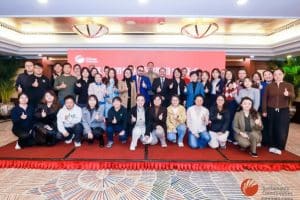To mark the second anniversary of the implementation of the Yellow River Protection Law of the People’s Republic of China, the first Youth Ecological Civilization Exchange Event in the Yellow River Basin was held from March 31 to April 1 in Qikou Town, Lüliang City, Shanxi Province. Guided by the Communist Youth League of Shanxi Province, the Shanxi Provincial Department of Ecology and Environment, and other agencies, the event was hosted by Jinqing Sustainable Development Public Service Center. It brought together young representatives, scholars, and social organizations from nine provinces along the Yellow River to explore opportunities for ecological cooperation.
Background
The Yellow River faces pressing challenges including water scarcity, pollution, and ecosystem fragility. Since its enactment in October 2022, the Yellow River Protection Law has provided legal foundation for advancing the systematic, stable and high-quality ecological protection and development across basin.
Progress
By 2023, the main course of the Yellow River met Class II water quality standards for two consecutive years—an achievement not seen in the past decade. Through joint efforts in ecological restoration, pollution control, and industrial restructuring by provinces such as Shanxi, Shaanxi, and Gansu, a coordinated governance framework between the upper and lower reaches of the river has begun to take shape.
Youth play an increasingly vital role in ecological civilization. Mi Xiaobing, Deputy Secretary of the Communist Youth League of Shanxi, noted that from early grassroots campaigns to recent youth education projects, young people and NGOs have emerged as a “third driving force” in addition to governments and industry. Organizers of event proposed establishing a “Legal Awareness Month” across the nine provinces to promote coordinative legal outreach.
Li Zhiling, Deputy Chief Judge of the Environmental and Resources Division of the Lüliang Intermediate People’s Court, stated that in recent years, the court has actively advanced the development of a specialized judicial system focusing on environmental public interest litigation.
Social organizations can help build grassroots networks for ecological protection through actions such as data monitoring, routine river patrols, and habitat conservation. These efforts contribute to a participatory ecological governance system model that engages wider public involvement.
Challenges and Structural Pressures
Public awareness and social participation are crucial to the success of Yellow River protection efforts. A joint survey conducted by Jinqing and Dataway, which included 4,542 individuals and 23 organizations across 46 key cities, found that while the public possesses basic knowledge of the Yellow River Protection Law, understanding of key provisions remains limited. Social organizations demonstrated slightly higher awareness level, though systematic training is still needed.
Ecologically concerns identified by both the public and NGOs include soil erosion, climate change, and excessive groundwater extraction. In terms of water quality, the main threats are heavy metal and chemical pollution from industrial mining, as well as contamination from urban sewage and agricultural runoff. Both groups emphasized the importance of improving urban sewage systems and limiting industrial and cultural pollution as essential to safeguarding water quality. Experts emphasized that the ecological challenges facing the Yellow River stem from multiple, overlapping pressures. Systematic governance is required to manage water resources, restructure industries, and restore ecosystems.
Zhang Yong, Director of the Qinghai Polar Institute, highlighted the severe ecological degradation in the river’s source area due to climate change and called for stronger protection measures and community cooperation. Wu Zhitao, professor at Shanxi University and Deputy Director of the Yellow River Laboratory, pointed out that the middle reaches of the river, which host China’s nine major coal bases, are plagued by declining groundwater levels, land subsidence, and vegetation damage. He argued that “bottom-up governance” is no longer sufficient to advocated a shift from “passive remediation” to “proactive governance.”
Experts agreed that a comprehensive system encompassing prevention, management, treatment, and restoration is needed to ensure ecological security and sustainable development in the Yellow River Basin. As the President Xi Jinping once stated, the goal is to transform the Yellow River into a “river of happiness that benefits the people.”
The way forward
At the conclusion of the event, participants gathered at the Qikou Yellow River Memorial to listen to the song Defend the Yellow River and recited the Qikou Declaration, reaffirming their commitment to the river’s sustainable future.
The declaration advocated for law-based river governance and proposed nine key action areas: strengthening legal enforcement, encouraging public participation, enhancing routine legal education, advancing ecological judicial systems, supporting public interest litigation, building inter-provincial cooperation networks, developing Yellow River protection case library, promoting green economies initiatives, and fostering cross-basin and international collaborations.
The declaration emphasized that only through the joint efforts of government, enterprises, social organizations, and the public can the Yellow River be truly protected, and ecological security and high-quality development be realized in tandem.
Event organizer Bai Juan concluded that April 1, the anniversary of the law’s implementation will serve as an annual occasion to promote legal awareness, judicial cooperation, and public engagement. This will help ensure that the law continues to serve as a powerful too in safeguarding the Yellow River, the “Mother River” of the Chinese nation.



